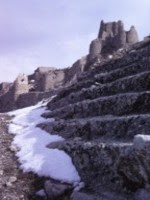Meetings in Autumn
The headlines tell the tale: Armenia and Turkey, at last, have made a kind of peace. At a meeting in Zurich on 10 October 2009, protocols were signed which, if approved by each country’s parliament, will lead to a normalization of relations. After a long flirtation chaperoned by the Swiss, a history-making visit by Turkey’s President to a football match in Yerevan, and a ceremony that stalled for over three hours at the last minute, it took the combined ministers and ministrations of France, Switzerland, Germany, NATO, Russia, the EU, and the US (kudos esp. to Hillary Clinton), all of them smiling through clenched teeth and, no doubt, rolling their eyes, to hammer together this union between a rusty nail and an ironwood plank. Next step: a football match in Turkey, to be attended by Serge Sarkisian, President of Armenia. If, as seems likely, the Turkish police can keep order at the match (my guess: one out of every three attendees will be a plainclothes officer), expect a ponderous, lurching march thereafter toward the goal of rapprochement. Sworn enemies on both sides will continue to make trouble (a recent tour by Sarkisian of Armenian settlements in Europe, the US, and Russia was accompanied by cries of “Traitor!”); still, observers are cautiously optimistic.
Meanwhile, another newspaper article reminds us of a far less famous event. As I write this, the Yezidis’ Feast of the Assembly is nearing its climax. Every October 6-12, when not kept away by war and violence, Yezidis from around the world make their annual pilgrimage to Lalish, a.k.a. Sheikh Adi, a tiny complex of temples, shrines, and tombs in the hills north of Mosul. From F&T:
The classic description of Sheikh Adi comes from Henry Layard, who in the fall of 1846 took time off from his dig at Nineveh to attend the Feast of the Assembly, the annual gathering of the Yezidi clans. Layard, himself not a clergyman and with no official need to pass judgment on “devil-worshippers,” simply recorded what he saw: a festival abundant with beauty and devoid of debauchery, with oil lamps sparkling among the olive groves by night; dancing maidens; the music of flutes and tambourines and the chanting of priests; crowds of white-robed Yezidis; giggling maidens with their black hair plaited in glass beads and gold.And who are the Yezidis? Definitely not “devil-worshippers,” as they have been labeled for centuries. Those who know about Turkey and Kurdistan, especially those who have read a certain book by me, will need no introduction. The Yezidis speak Kurdish, and yet, after years of strife with their Kurdish neighbors, they do not really consider themselves Kurds. In recent years their villages have suffered greatly from terrorist truck bombs, probably set by Sunni Arab jihadists, and they still live in fear. But they too, have shown their own violent side, as when two years ago a Yezidi girl was caught on video being stoned to death by her Yezidi relatives. (Her crime? Wearing jeans, being seen with a Sunni Arab boy.) In recent decades much more has been learned about their religion, a mixture of angel worship, Zoroastrianism, and other elements. Still, no one can really say where their religion comes from, and as to the origin of their name, whether Yezidi, Ezidi, and Yazidi, the multiplicity of theories leads one to believe that, in all likelihood, none of them are correct.



0 Comments:
Post a Comment
Subscribe to Post Comments [Atom]
<< Home